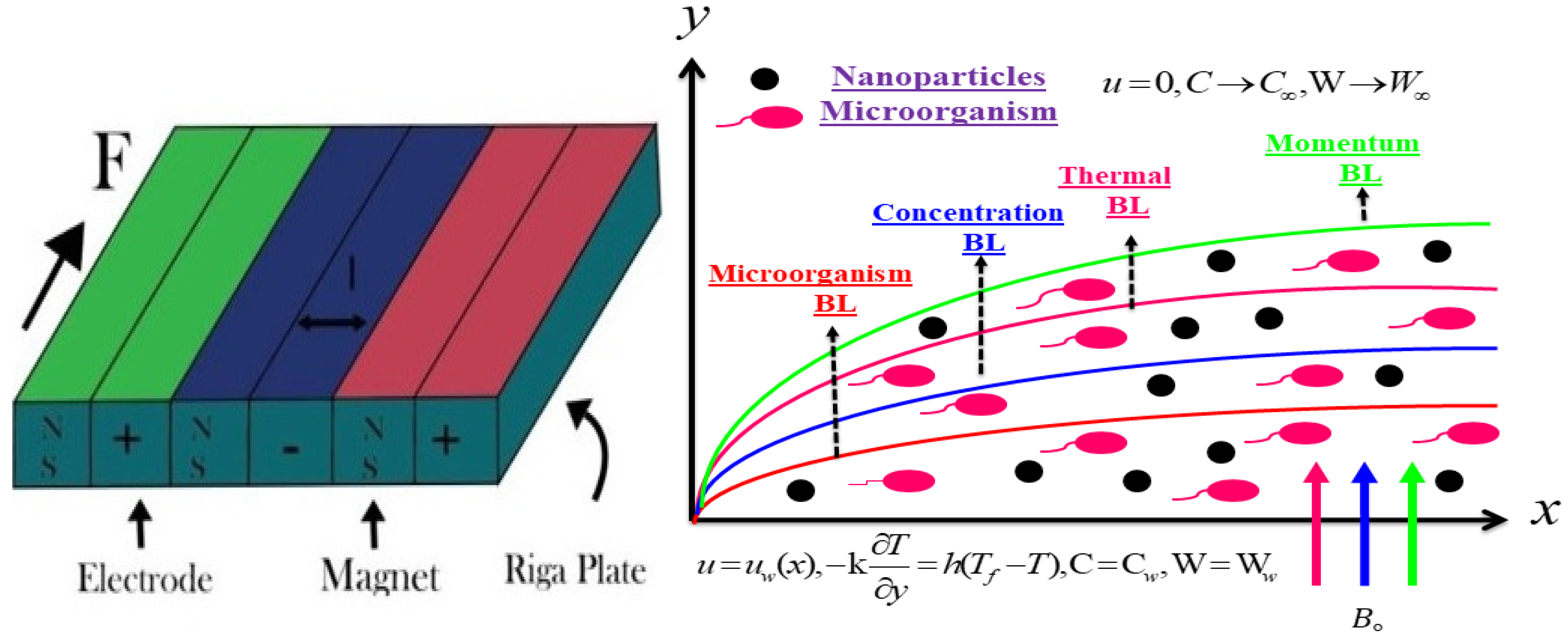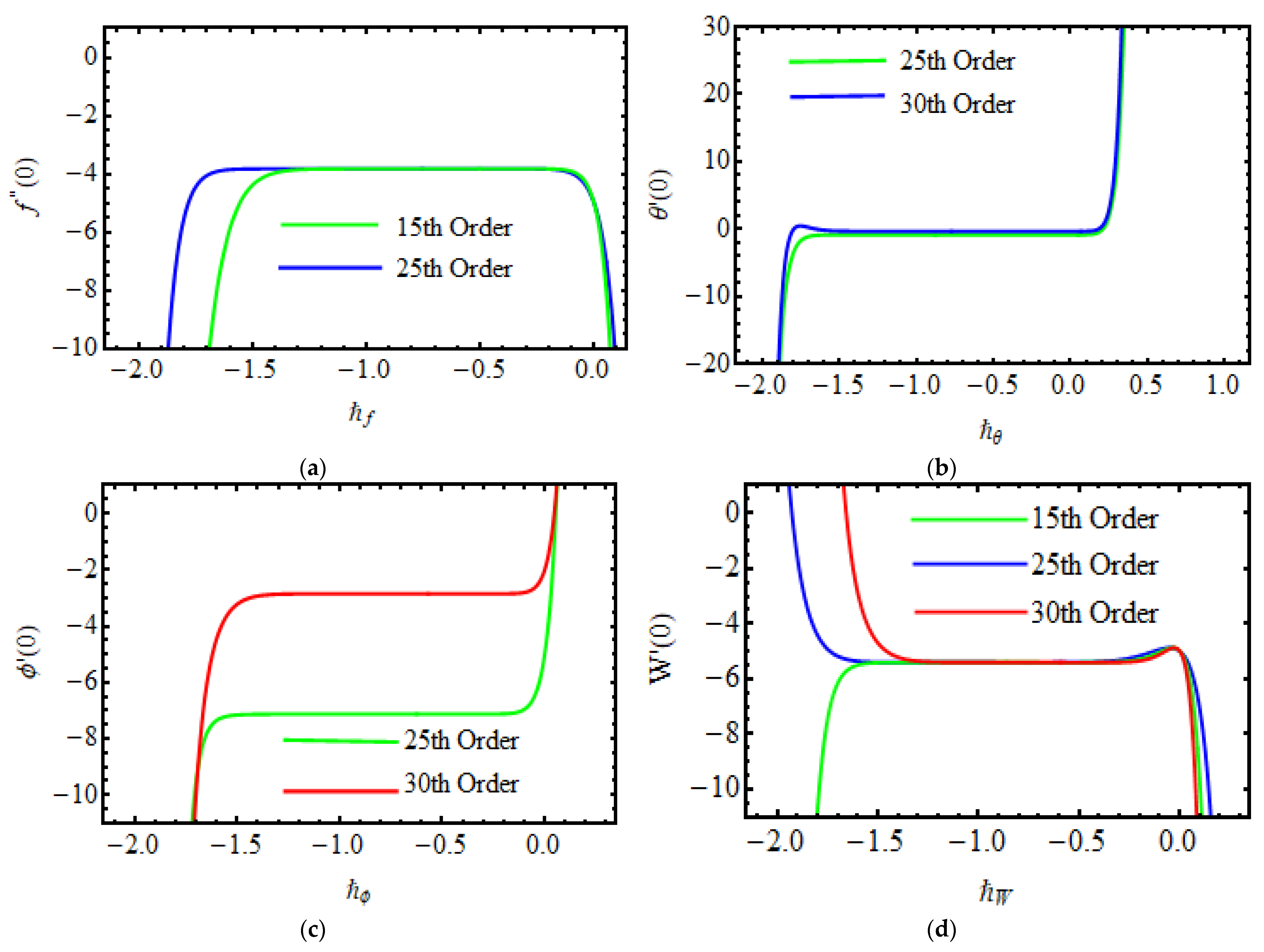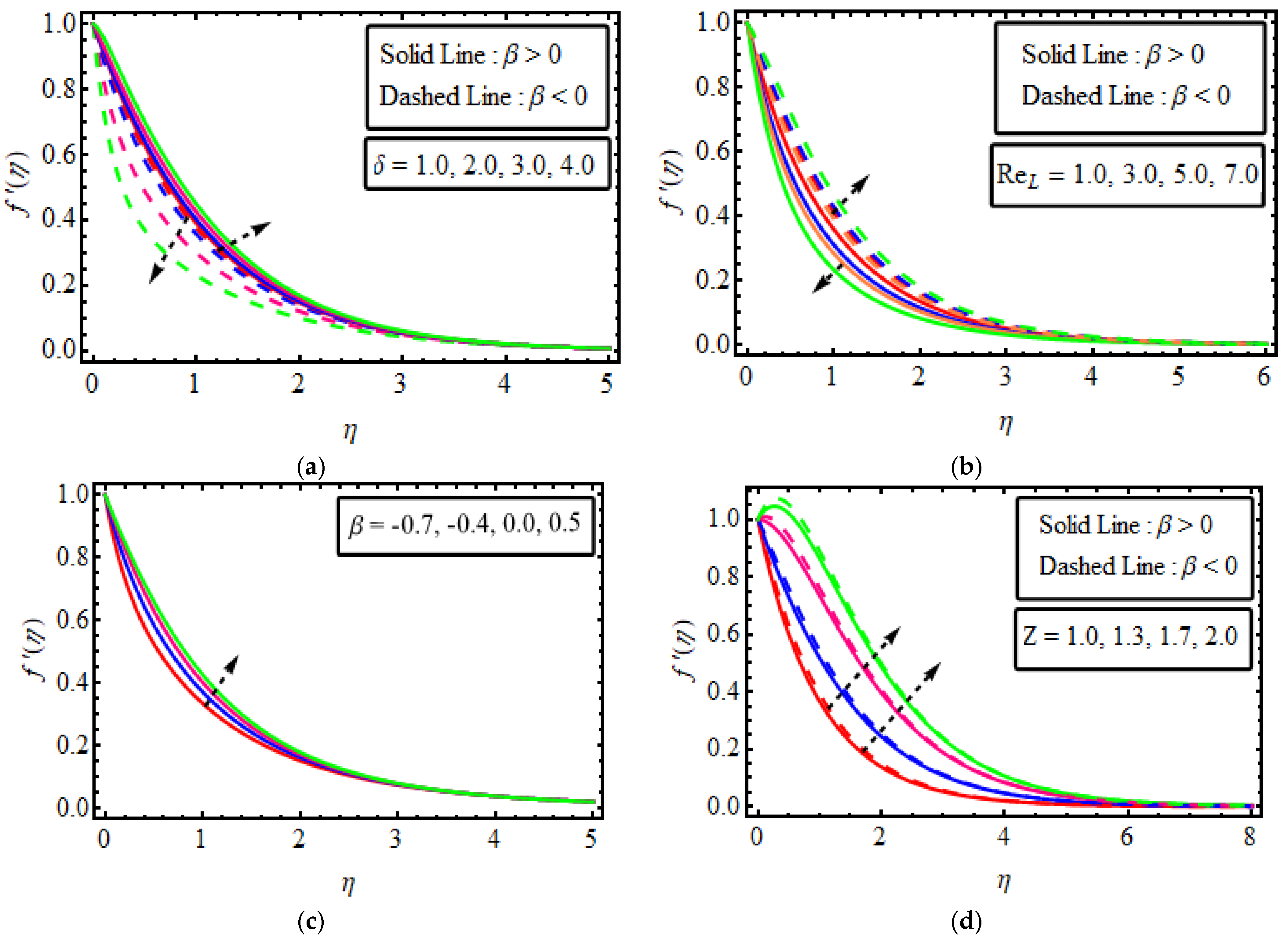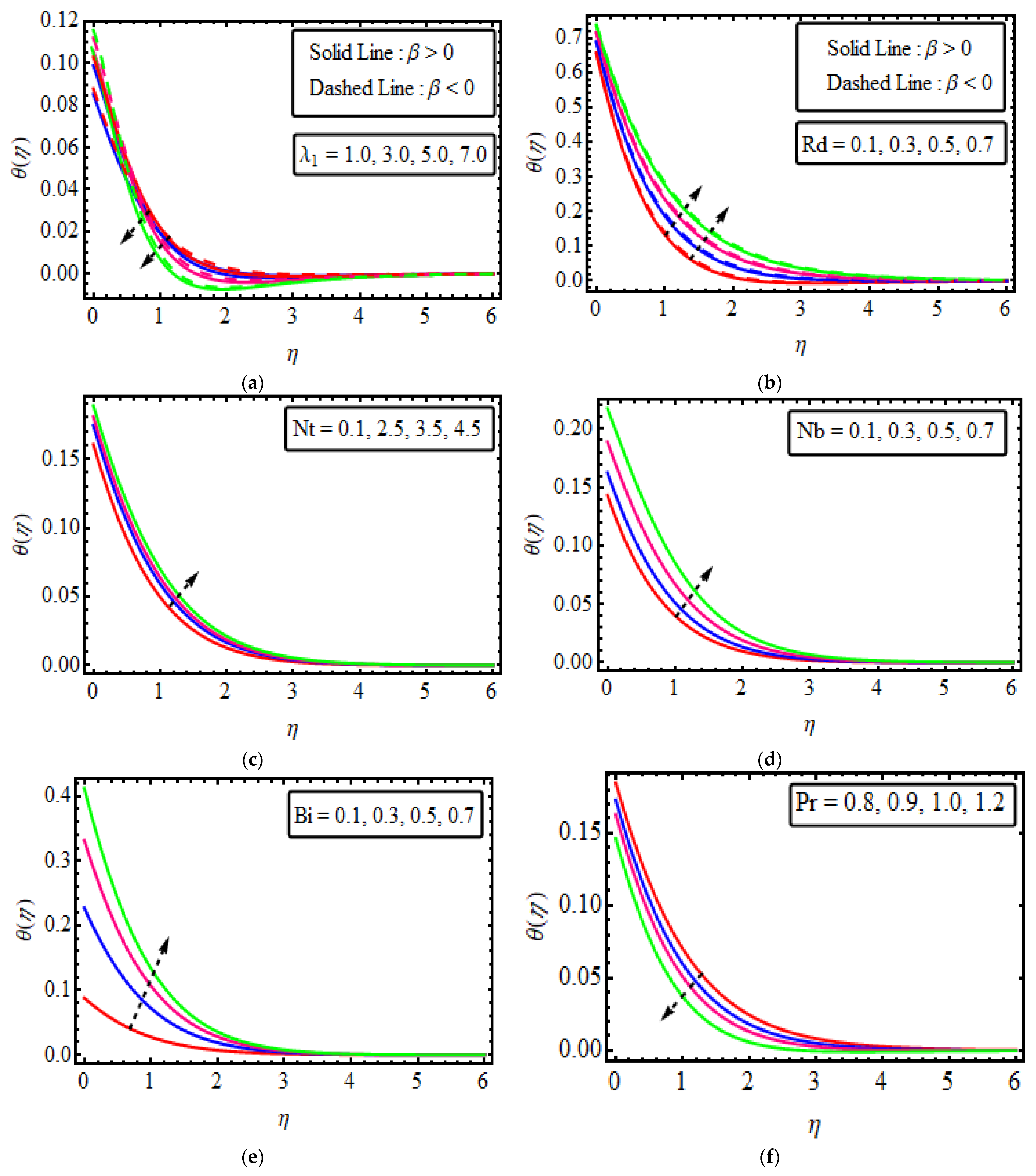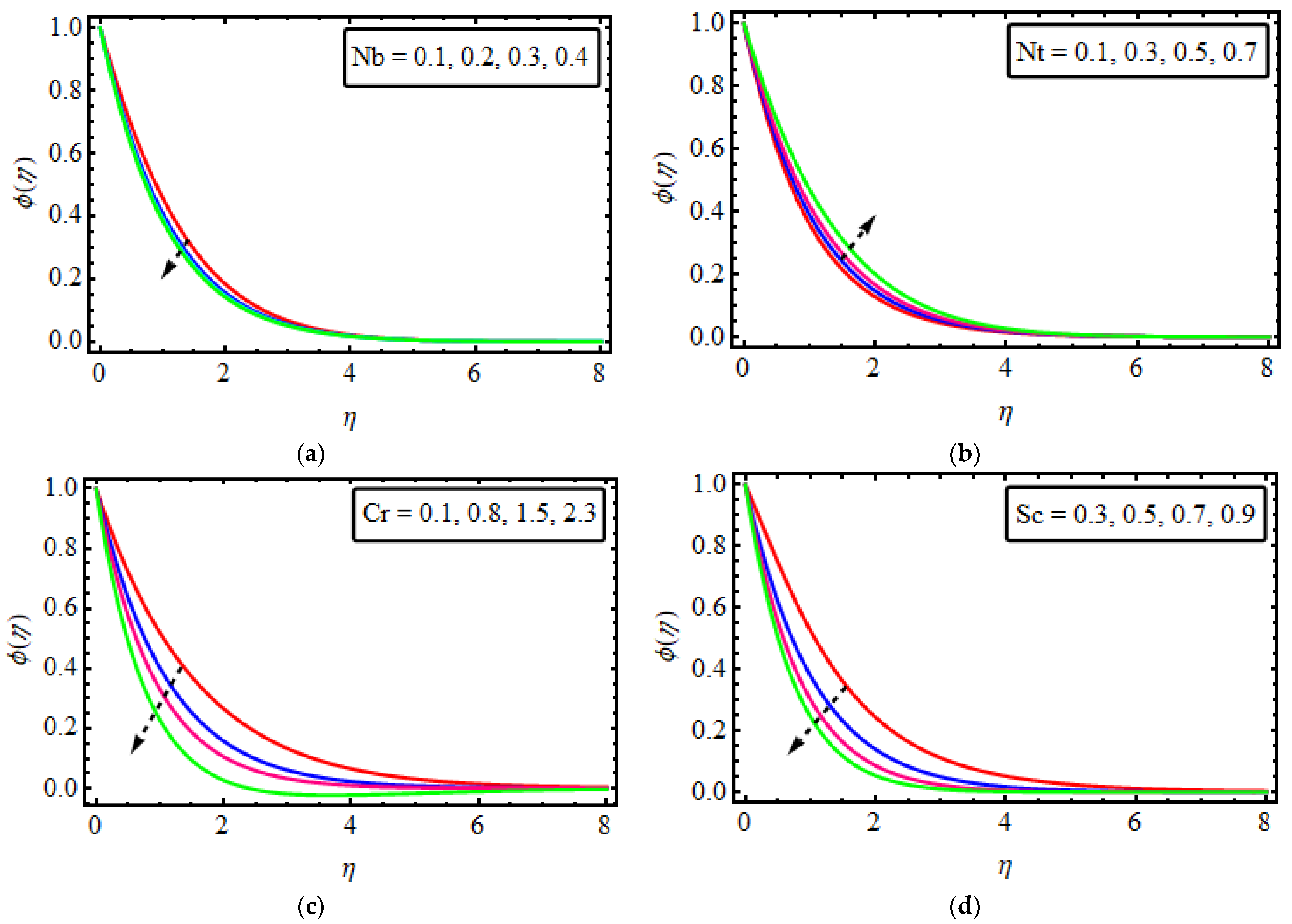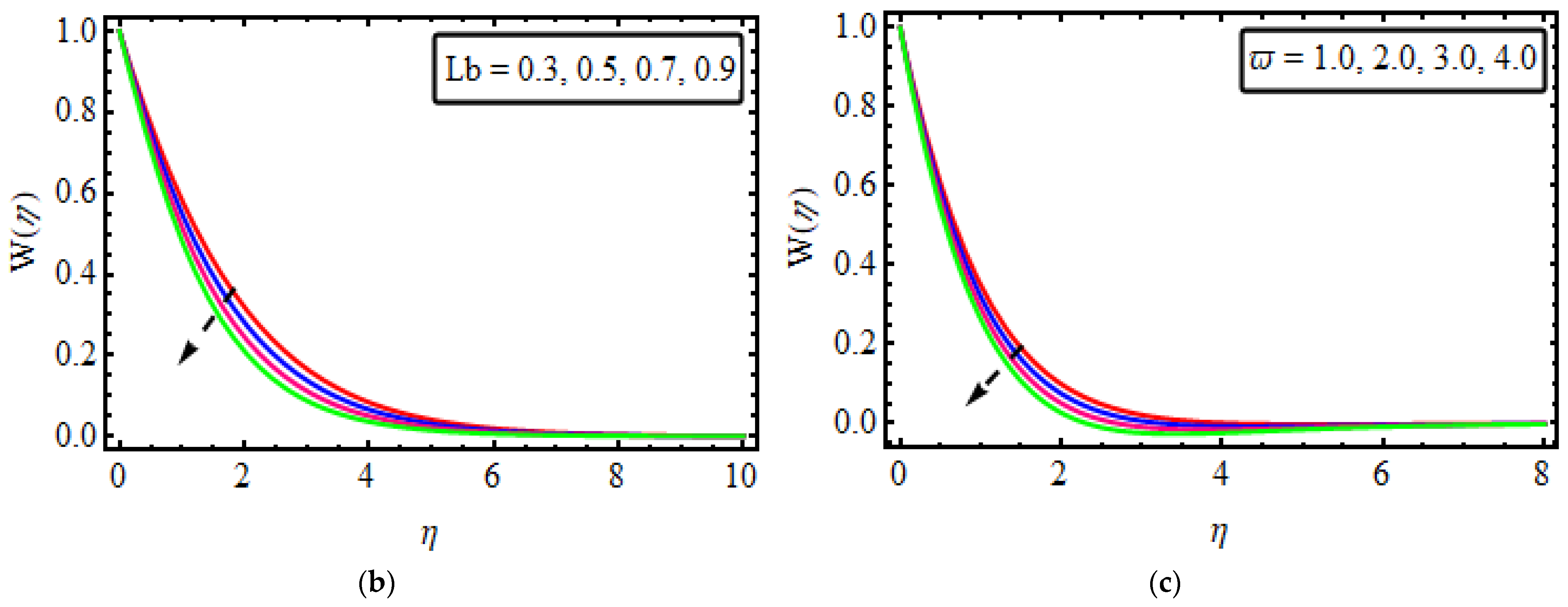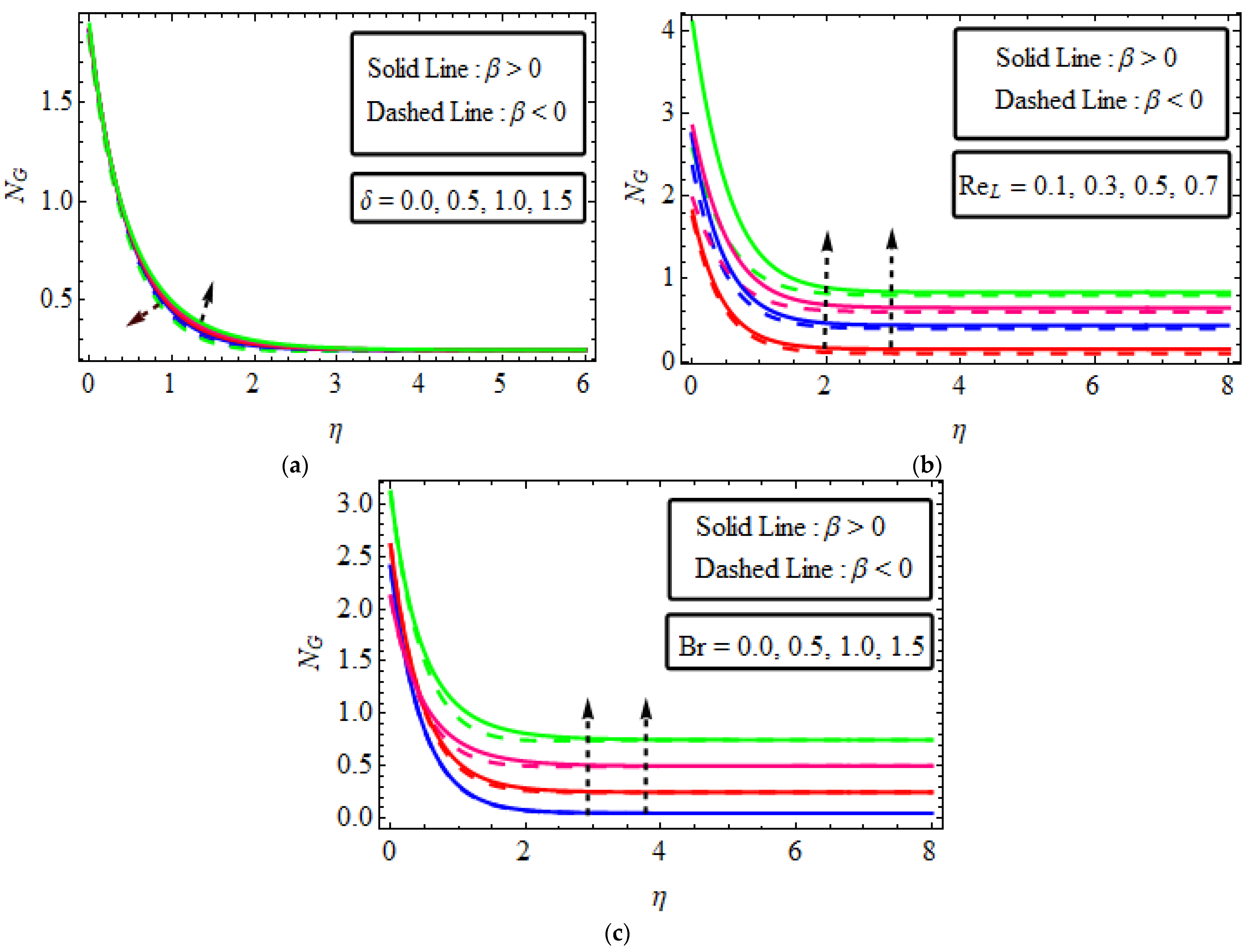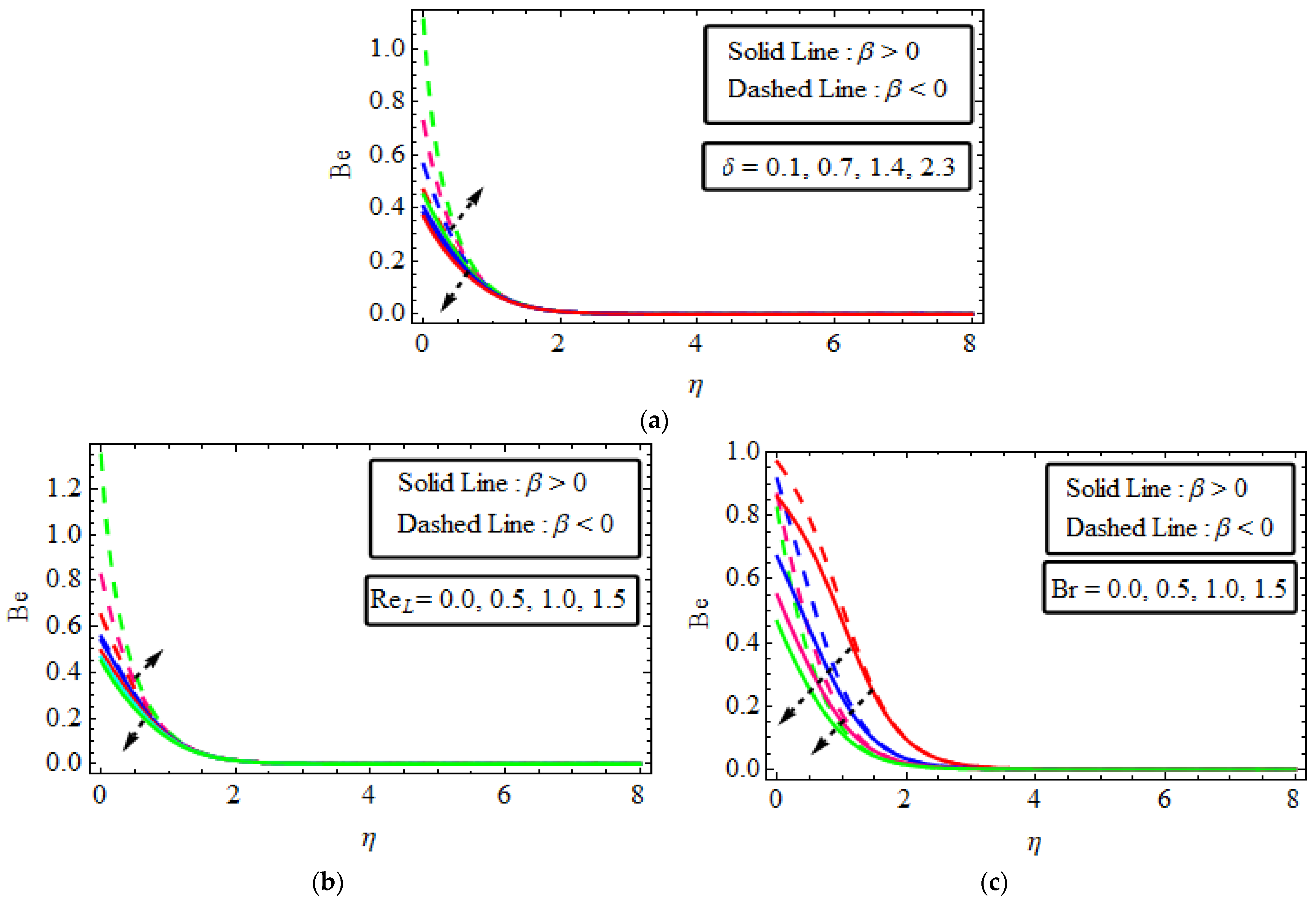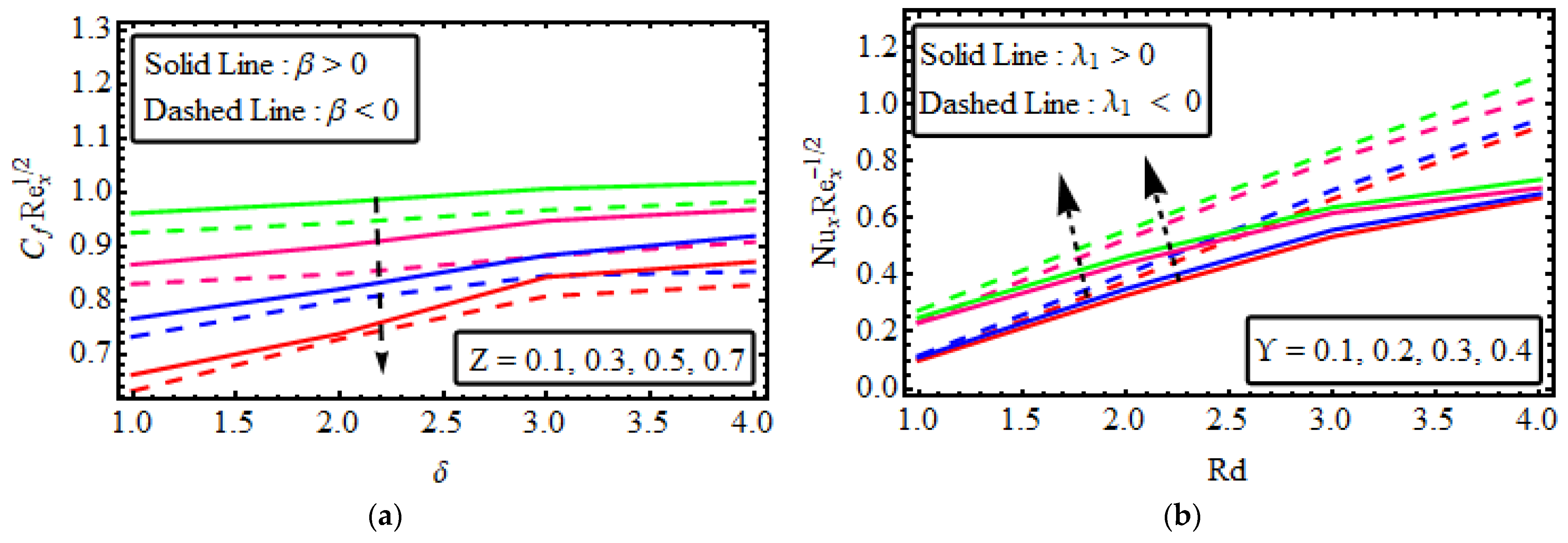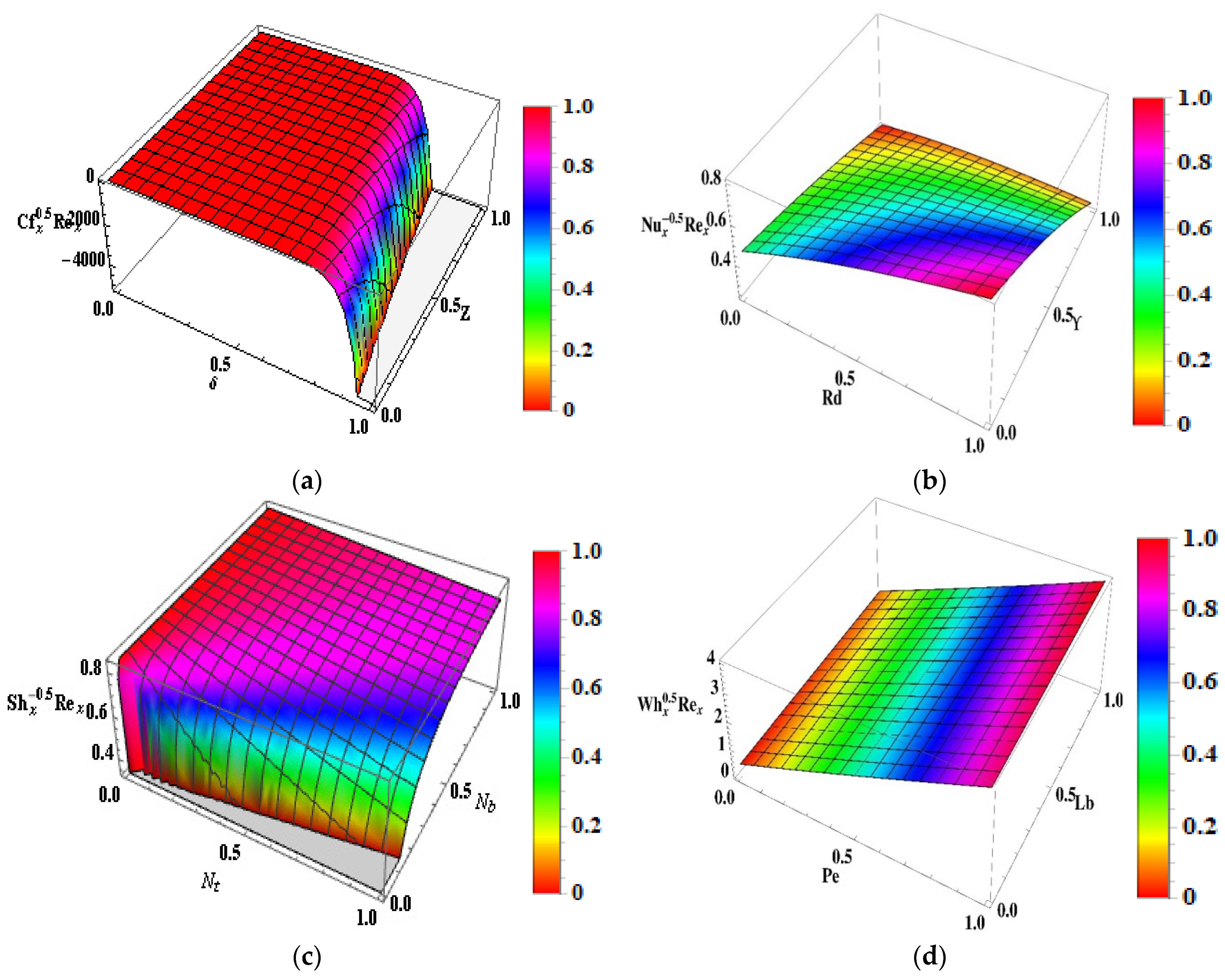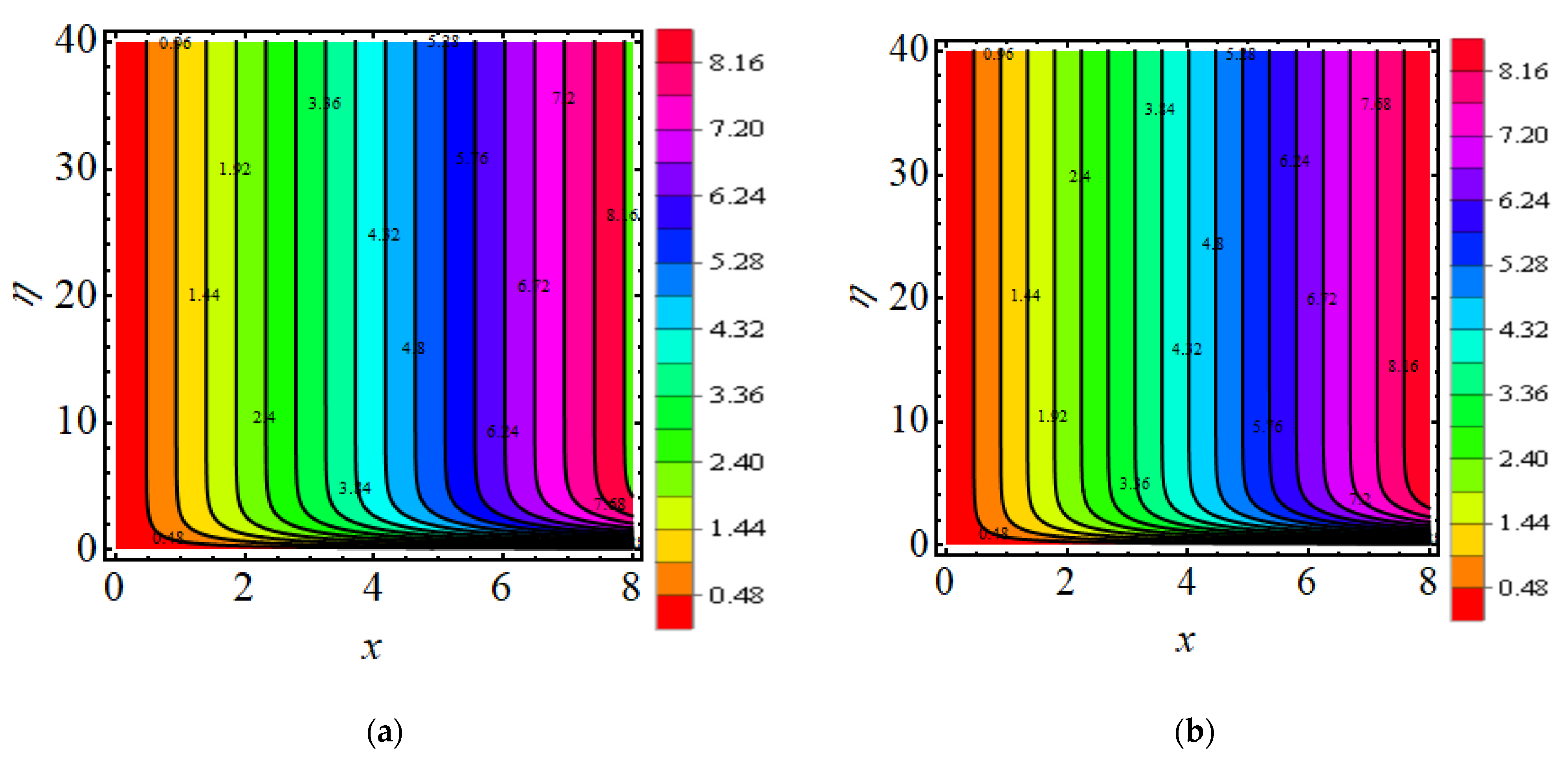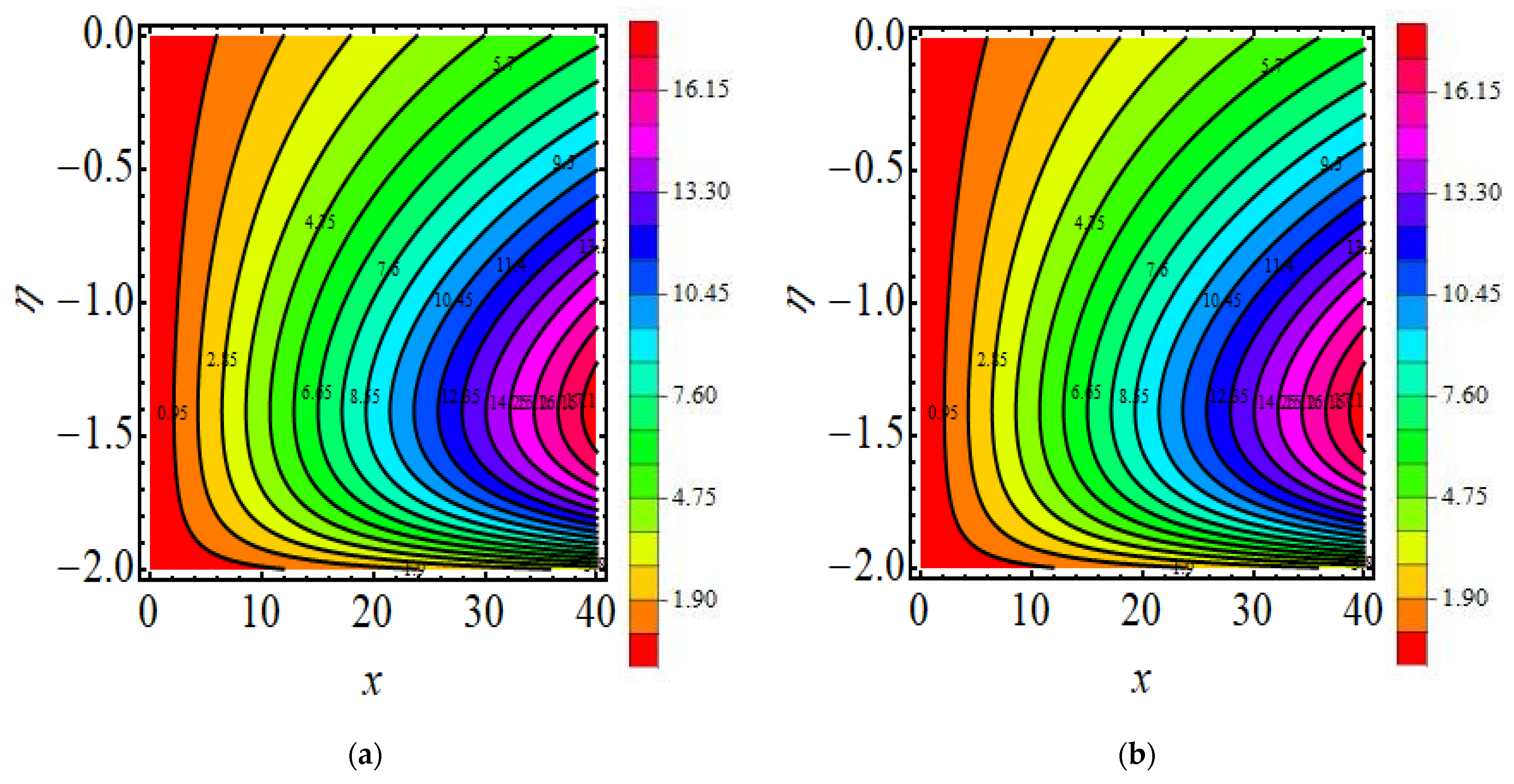1. Introduction
The rate of heat transport characteristics is a subject of enduring interest for various researchers and scientists owing to its tremendous industrial applications, for example, in mechanical, optical, electrical, and cooling instruments. The rate of heat transport increment is very crucial in depositing energy. Thus, researchers are focused on the investigation of a new fluid substance that is a mixture of nanoparticles 100 nm in size and more thermophysical properties than ordinary fluid, known as nanoliquid. Nanoliquid is the colloidal suspension of the nanoparticles’ thermal behaviour of the ordinary fluid. The first endeavour was performed by Choi et al. [
1] in 1995. They exposed the thermal conductivity of nanoliquid by adding nanosized particles. Later, Buongiorno [
2] used this notation of nanofluid to make a mathematical form by adding terms known as Brownian and Thermophoretic. The mixed convection nanofluid flows with different surfaces and geometry were conducted by Hussain et al. [
3,
4], and Haq et al. [
5] deliberated the second law analysis on a cross nanofluid. The impact of microorganisms on the Darcy flow of Sutterby nanofluid, taking into account microorganisms over movable cylinders, was examined by Aldabesh et al. [
6]. Mankiw et al. [
7] analysed the MHD time-dependent flow of nanofluid with variable properties due to an inclined stretching sheet under thermal radiation. Shahid [
8] demonstrated the effect of upper convective flow of Maxwell liquid over a permeable surface near the stagnation point. Rafique et al. [
9] addressed the stratified micropolar nanofluid flow past an exponentially stretchable plate with the Riga surface. The unsteady viscous flow of nanofluid over the Riga plate using a rotating plate was investigated by Parvine et al. [
10]. Abbas et al. [
11] deliberated the entropy production over the Riga plate and the suction case. Sannad et al. [
12] using a non-homogeneous dynamic model, which is more accurate in physically describing nanofluids than homogeneous ones, wherein free convective flow in a cubical cavity filled with copper-water nanofluid was explored numerically. Some of the latest developments in nanofluids were obtained from references [
13,
14,
15,
16,
17,
18,
19].
Different fluid forms, including polymer melts, colloidal suspensions, organic chain mixes, etc., are used in a wide range of industries and production processes. The rheological behaviour of these fluids cannot be well described by the Naiver–Stokes equation alone. Therefore, several nonlinear fluid models are proposed to represent the rheological characteristics of complicated fluids. One non-Newtonian fluid model used to examine key characteristics of pseudoplastic and dilatant fluids is the Sutterby fluid model. Numerous experts have extensively studied the flow of Sutterby liquid. Waqas et al. [
20] inspected Sutterby nanofluid using two rotating disks. Yahya et al. [
21] investigated Williamson Sutterby nanoparticles under the Cattaneo–Christov heat flux. The effect of MHD on Sutterby nanoparticles due to porous movable sheets was discovered by Fayydh et al. [
22]. Gowda et al. [
23] examined the Cattaneo–Christof theory of heat diffusion in Sutterby nanofluid. The impact of thermal radiation and heat source/sink on Sutterby nanofluid has been studied by Ali et al. [
24]. Hayat et al. [
25] investigated the Sutterby fluid with thermal radiation due to a rotating disk. Recently, Fujii et al. [
26] addressed Sutterby fluid with natural convection flow due to a vertical plate. The Darcy surface with MHD flow of Sutterby fluid was reported by Bilal et al. [
27]. The bioconvection flow of Sutterby nanofluid due to a rotating disk was described by Khan et al. [
28]. Sohail et al. [
29] designed the free convection flow of Sutterby fluid with heat under the Cattaneo–Christov theory. The heat generation/absorption in the thermally stratified flow of stagnant Sutterby fluid through a linearly stretched plate is analysed in this article by Saif et al. [
30]. Usman et al. [
31] investigated the two-dimensional stagnant flow of Sutterby nanofluid across a stretching wedge placed in a porous media. Song et al. [
32] discussed the two-dimensional flow of Sutterby nanofluids over a stretching cylinder, scrutinized in the presence of bioconvection and swimming microorganisms. The influence of homogeneous heterogeneous reaction on Sutterby fluid flow by a disk with Cattaneo–Christov heat flux is studied by Khan et al. [
33].
In the modern period, the research on bio-convection exists due to the motion of microorganisms upwards because microorganisms are denser than water. The upward surface of the fluid develops thickness as a result of the collection of the microorganism. For this reason, the upper surface becomes disturbed, and microorganisms sink, which develops bioconvection. Bio-convection continues to be the subject of research broadly due to its many applications in the clinical area, manufacturing process, and biofuel production. Bio-convection could be organised as consisting of the motion of direction with a vast number of microorganism species. In this way, gyrotactic microorganisms are among those whose swimming direction is based on viscous torque and gravitational force. Kuznetsov et al. [
34,
35] reported the early investigation of bio-convection in the mixed suspension of nanoparticles with gyrotactic microorganisms. Kotha et al. [
36] examined the MHD flow of nanofluid with motile gyrotactic microorganisms over a vertical plate. Siddiq et al. [
37] numerically analysed the bioconvection of micropolar nanofluid flow restricted through the stretchable disk using the bvp4c method. Bagh et al. [
38] studied the effect of bioconvection and Cattaneo–Christov with a vertical stretching sheet. Azam et al. [
39] investigated the effect of bioconvection flow for the Sutterby nanoliquid with nonlinear radiation. Khashi’ie et al. [
40] tested a hybrid nanofluid that had bioconvection with gyrotactic microorganisms. Azam [
41] explored the time-dependent flow of the chemically reactive Sutterby nanofluid and the influence of gyrotactic microorganisms. Hayat et al. [
42] operated the bio-convection flow of nanomaterial subject to melting effect. They addressed thermal nonlinear radiation and Joule heating for heat distribution characteristics. Reddy et al. [
43] analysed the time-dependent flow of Cross nanofluid comprising the gyrostatic microorganisms due to slip velocity. Sarkar et al. [
44] defined Sutterby nanofluid flow as having motile gyrotactic microorganisms over the Riga plate. Shah et al. [
45] described the heat transfer properties of a magnetohydrodynamic Prandtl hybrid nanofluid over a stretched surface in the presence of bioconvection and chemical reaction effects. Ali et al. [
46] explored the fluctuating temperature with Cattaneo–Christov features and self-motivated bioconvective microbes immersed in the water-based nanofluid, observed with the excision/accretion of the leading edge.
Riga plate is an electromagnetic actuator, which is made by the combination of a span-wise aligned array of alternating electrodes and permanent magnets. This actuator is responsible for producing a Lorentz force that decreases exponentially. It is important to note that when an external magnetic field is applied to a fluid with high electrical conductivity, it has a provocative effect. However, this device has been used to reduce pressure drag by preventing boundary layer separation and reducing the generation of turbulence requirements. Riga plate was first introduced by Gailitis and Leilausis [
47], and they generated a wall paralleled by Lorentz force to control the fluid flow. Further, in contrast to this, the Grinberg term was introduced with a most important feature that the boundary layer of the momentum equation is fully separate from the flow, and exponentially decreases in the direction of the normal to the plate. Subsequently, the Lorentz force was detected over a Riga plate, and then the researchers regained interest in the Gailitis–Lielausis actuator. Islam and Nasrin [
48] described the one-dimensional unsteady micropolar fluid flow set in a porous medium along with an inclined infinite Riga plate. Nasrin et al. [
49] explored the impulsively started horizontal Riga plate in two-dimensional unsteady Casson fluid flows with rotation. Anjum et al. [
50] concentrated on thermal stratification in the flow of second-grade fluid past a Riga plate with linear stretching toward a stagnation region. Hayat et al. [
51] investigated the convective heat transfer of electron magnetohydrodynamic squeezed flow past a Riga plate. Wahidunnisa et al. [
52] stduied a mixed convective nanofluid flow along a heated Riga plate with viscous dissipation and heat source. Iqbal et al. [
53,
54] have found the stagnation point flow of the melting heat, thermal radiation, and viscous dissipation effects on the Riga plate using erratic thickness, and considered the Casson fluid stagnation point flow along with a Riga plate. Vishnu et al. [
55] discussed the γ Al
2O
3–Water/Ethylene Glycol over a Gailitis and Lielausis device with an effective Prandtl number.
Newtonian fluids have been mostly discussed as base fluids in the prior work. We were motivated to examine Sutterby as a base fluid along with the Riga plate and chemical reaction effects with Cattaneo–Christove double diffusion for microorganism flow of nanofluids due to stretching surface because there have been so few studies on them. These facets of the issue, as far as the authors can tell, are not taken into consideration in the investigations that have already been done. The improvement of heat and mass transportation is the main goal of this extensive investigation. The current investigation was encouraged to express the Sutterby nanofluid inserted on a porous surface with Cattaneo–Christof double diffusion due to the Riga plate containing gyrotactic microorganisms. The chemical reaction and heat source-sink are considered worthy of attention. The leading aim of this work is an inclusive analysis of this flow problem. The coupled equations of the current flow problem are altered into the nonlinear system by applying suitable correspondence transformations. Further, the solution of ordinary differential equations is utilized via the Homotopy Analysis Method (HAM). The novel outcomes of the current work are obtained through different parameters and explained with the assistance of graphs and tables.
3. Fluid Flow Problem
Cauchy Stress tensor
for the Sutterby fluid [
56,
57]
Sutterby viscosity model is represented as
where
n,
,
, are described as power law index, zero share rate viscosity, and time material constant.
Using Equation (2) in Equation (1), we have
The governing equation of the following form [
23]
where
u and
v are velocity components in the
x and
y- directions.
represents kinematic viscosity of the fluid,
represents kinematic viscosity of the fluid,
represents the density of the fluid,
represents thermal diffusivity,
is the concentration,
represent Brownian diffusion and thermophoretic diffusion,
denotes volumetric expansion,
represents the microorganism coefficient,
and
fluid relaxation time,
In the above equations, the terms
are stated as
The relevant boundary conditions are assumed to be the form
where
can be expanded as follows:
Replacing Equation (12) into Equation (13),
Introducing the similarity variables [
24]
Using Equation (15), Equations (4)–(6) become
The corresponding boundary conditions are
where
is the Modified Hartmann number;
is the Reynolds number;
is the Deborah number;
is the Radiation parameter;
is the Prandtl number;
is the Brownian motion parameter;
is the Thermophoresis parameter;
is the Schmidt number;
is the Biot number;
is the Peclet number;
is the Bio convection Lewis number;
is the Chemical reaction;
is the Magnetic number.
The thermo-fluidic quantities of engineering interest in this study are skin friction
, heat transfer rate
, mass transfer rate
, and motile density
.
where
surface shear stress,
surface heat flux,
surface mass flux, and
motile density are given by the following expressions:
The dimensionless form of the above parameters is expressed as
Here, is the local Reynolds number.
11. Velocity Field
The effects of different numerous parameters on velocity distribution
are discussed in
Figure 3a–d.
Figure 3a shows that for pseudoplastic, the velocity of fluid lessens with the larger value of Deborah number
, and the velocity field is enhanced for the rising value of Deborah number
for the two cases of when
and
. This result is shown to be the same as in F. Ali et al. [
56].
Figure 3b shows that the velocity curve
shortens with increasing values of the Reynold number
in the case of
; a higher
, the more diminished the viscous force and hence fluid depreciates for the pseudoplastic fluid. Thus, for shear thickening fluid, the velocity field enhances as
increasing the impact of the values of
in the two cases. As shown in the figure, the velocity for both values
shows mixed behaviour with increasing fluid parameters. The Reynold number described the proportion of inertial to viscous forces due to this inertial force being prominent for the two cases of velocity magnitude when
and increases when
.
Figure 3c manifests the effect of the enhanced power-law index
parameter, resulting in a better velocity profile for shear thickening fluid.
Figure 3d demonstrates the significance of the Hartmann number
on velocity fluid field for the two cases of
and
. It has been revealed that with changes in the strength of
the velocity of the fluid escalates in both cases. Physically, an increment in
corresponds to enhancing the external electric field that constructs wall-parallel Lorentz force. Therefore
rises. The velocity is more pronounced for pseudo-plastic fluid than a fluid dilatant fluid with increasing
for the shear-thinning as well as shear-thickening fluid.
12. Temperature Field
Figure 4a–f plotted the consequences of temperature
against different values of various involved parameters. The thermal relaxation time parameter causes are demonstrated in
Figure 4a. The thermal relaxation parameter tends to decrease the temperature curve in both cases of dilatants and pseudoplastic. It impacts the strength of heat transfer. So, the dissimilar decayed impact of
on the temperature field takes place away from the surface.
Figure 4b reveals the inclination of
for specific values of thermal radiation parameters fo
and
The temperature of the fluid increases due to the enlargement in the radiation parameter
in both cases. Physically, by increasing the radiation parameter more energy is added to the system, which uplifts the kinetic energy of molecules and also causes a rise in the temperature profile.
Figure 4c shows that temperature increases with the increments in the values of
. Thermophoresis is a phenomenon where small particles diffuse under the effect of a temperature gradient. An increase in the value of the thermophoresis parameter sets the nanoparticle in motion, and thus on the hotter side, the momentum of the nanoparticles rises. Due to the rise in the momentum, nanoparticles transfer their kinetic energy in the direction of the cooler side, and thus the region gets warmed up quickly; i.e., the temperature of the fluid is increased.
Figure 4d also suggests that the nanofluid temperature rises with the increasing value of the Brownian motion parameter
, and the opposite effect is examined in the
Figure 4e. The reason behind this is that Brownian motion is the irregular movement of the particles suspended in the fluid. The temperature of the fluid increases as a result of the random collision of particles suspended in the liquid, which further leads to an expected improvement in the temperature profile
Figure 4e depicts the impact of the Biot number
. These figures point out that the temperature field is boosted by enhancing the value of the Biot number. It seems that the value of the Biot number is directly proportional to the temperature, as the higher value of
corresponds to greater convective heating along the sheet, which increases the temperature gradient on the sheet. Therefore, the thickness of the boundary layer and temperature are increasing functions of the Biot number.
Figure 4f display variations of the Prandtl number against
. Temperature is restrained against higher
. Basically, the Prandtl number refers to thermal diffusivity. Larger
indicates lower thermal diffusivity, which causes the temperature to decompose.
17. Physical Entitles
Figure 9a shows that the skin friction coefficient
is deformed in both cases for the larger values of the parameter when
and
. The influence of the non-Newtonian nanofluid parameter on the Nusselt
against thermal radiation
are highlighted in
Figure 9b. The heat transport gradient upsurges with rises in the thermal radiation
and heat source/sink parameters
. The significance of
and
on the Sherwood number is intimated in
Figure 9c. It is determined that there is an amplification in the Sherwood number
for raised values of fluid parameters.
Figure 9d elucidates the substantial rescaled density number of motile microorganisms. The rescaled density number of motile microorganisms is voluminous for higher variations of
and
.
Figure 10a–d shows the 3D representation of the Skin, Nusselt, Sherwood and Motile density respectively.
The numerical estimation of drag friction
has been given in
Table 3. The larger the magnitude of
, the lower the drag friction.
Table 4 and
Table 5 produce the data of heat and mass related to the diverse value of
. Here it is illustrated that the magnitude of heat and mass transport is increased via a large value of
for the Nusselt number
and for the Sherwood number.
Table 6 shows the variation of
on the motile density profile. In
Table 6, it is shown the motile density profile is the leading function
.
